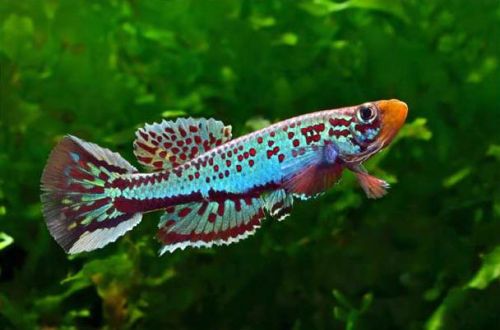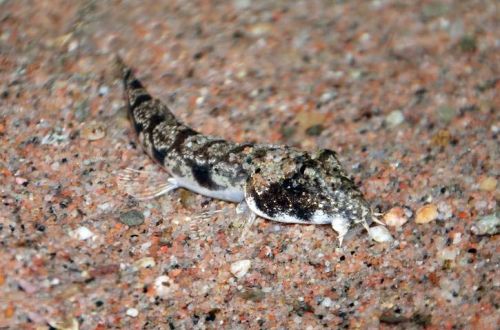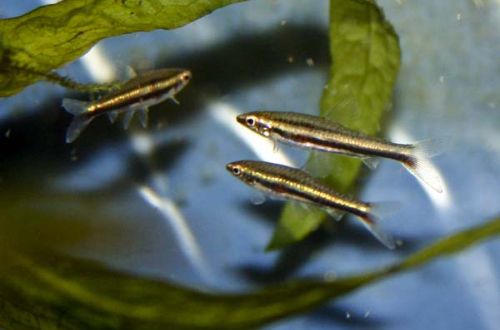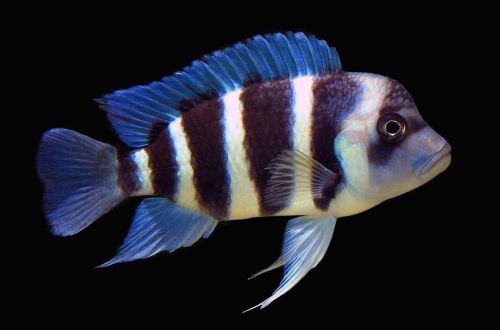
Queen of Tanganyika
The lobed Cyphotilapia zebra or Queen of Tanganyika, scientific name Cyphotilapia frontosa, belongs to the Cichlidae family. Also known as Frontosa blue, it is a Russian-language transcription of the English-language trade name “Blue Zaire Mikula”.
Endemic to Lake Tanganyika in East Africa, found throughout the western and eastern coasts. It lives among the rocky coastline at a great depth of 15-70 meters. A carnivorous predatory species, but at the same time quite peaceful if kept with fish of a similar size. The need for a large aquarium and productive equipment implies serious expenses, so this species can hardly be recommended to beginner aquarists.

Contents
Description
Adult individuals reach a length of up to 25 cm. A characteristic feature of the species is the presence of a large hump on the forehead, which is most pronounced in males. Otherwise, sexual dimorphism is weakly expressed. The body pattern consists of wide dark vertical stripes on a light background, the fins and tail are painted in blue or blue.
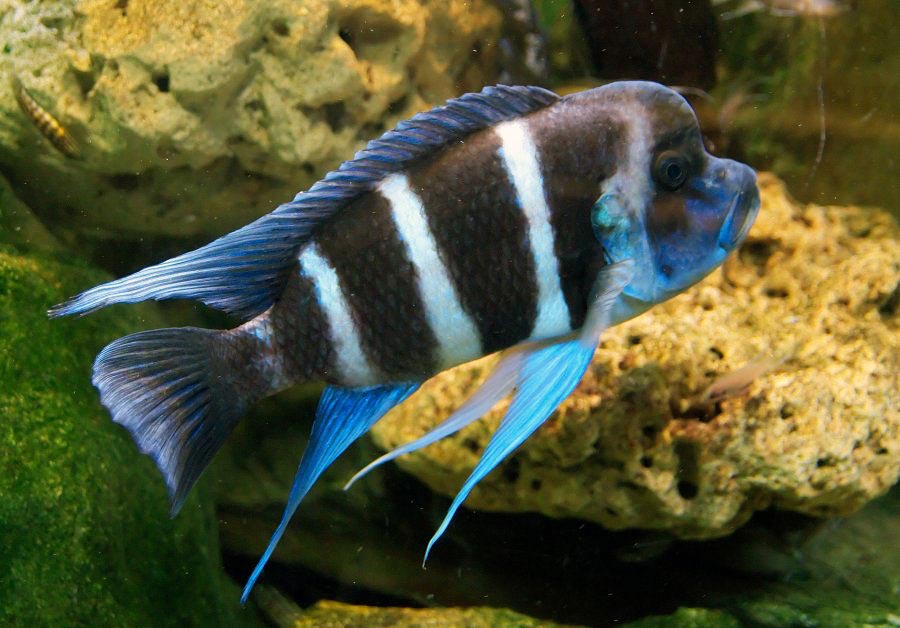
Brief information:
- The volume of the aquarium – from 800 liters.
- Temperature – 23-27°C
- Value pH — 8.0–9.0
- Water hardness – medium to high hardness (10-25 dGH)
- Substrate type – sand or gravel
- Lighting – subdued
- Brackish water – no
- Water movement is weak
- The size of the fish is 22–25 cm.
- Nutrition – meat feed with vegetable additives
- Temperament – conditionally peaceful, can eat small fish
- Content in a group of at least 6–10 individuals
Food
A predatory carnivorous species, in nature it feeds on small fish, invertebrates, mollusks, as well as algae that enter the diet when Frontosa eats prey from the surface of rocks and stones.
In a home aquarium, high quality foods such as live or frozen brine shrimp, mosquito larvae, and shrimp and mussel meat should be fed in combination with herbal supplements such as spirulina flakes. It is not necessary to feed live small fish. Some manufacturers produce specialized foods for the predatory species of Malawian and Tanganyika cichlids, which can be a great alternative.
Maintenance and care, arrangement of the aquarium
A group of 6-10 fish needs a spacious aquarium with a volume of 800-1000 liters. In the design, it is enough to use a sandy and / or gravel substrate and heaps of stones and rocks, from which shelters are formed in the form of caves and grottoes. Simple ceramic pots turned on their side, or some decorative objects, will also work as shelters. The lighting level is subdued, simulating conditions in the water column. There is no need for plants.
Due to the size of the fish and their diet, special attention should be paid to the quality of the water and its hydrochemical composition. Along with a weekly change of part of the water (20–25% of the volume), it will be necessary to install a productive filtration system, as well as regularly clean the soil from organic waste.
Behavior and Compatibility
The content in the group is at least 6-10 individuals. Intraspecific relationships are built on the dominance of one or two alpha males who have the right to mate with females. Relation to other species is completely determined by their size. Fish of a similar size are not threatened, while small fish will be eaten.
Breeding / breeding
Frontosa males are polygamous and should be kept in company with at least 3-4 females. With the onset of the mating season and in the presence of a suitable cave, the female lays several dozen large eggs. After fertilization, she takes them into her mouth. During the next 35-50 days, the eggs, and then the fry, are in the female’s mouth until they reach a certain size, and only then they go to free swimming. Feeding of juveniles occurs in the same place in the oral cavity, by swallowing a suspension of microfeed by the female.
In the absence of a cave or grotto, spawning can occur directly on the open ground, however, in this case, the female will not have shelter and there is a possibility of her being pursued by the male and other fish.
Fish diseases
The main cause of most diseases of cichlids from Lake Tanganyika is unsuitable housing conditions and poor quality food, which often leads to such a disease as African bloat. If the first symptoms are detected, you should check the water parameters and the presence of high concentrations of hazardous substances (ammonia, nitrites, nitrates, etc.), if necessary, bring all indicators back to normal and only then proceed with treatment. Read more about symptoms and treatments in the Aquarium Fish Diseases section.



